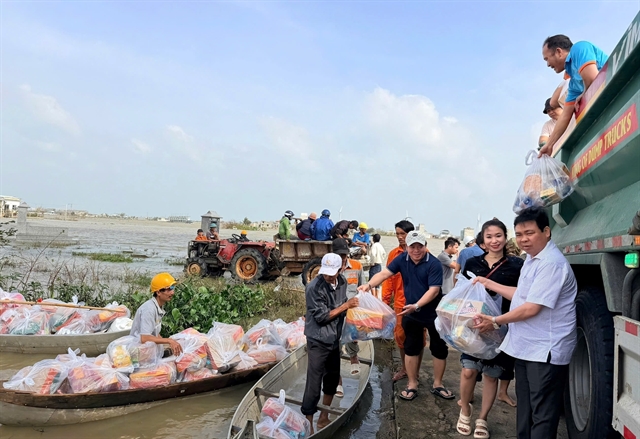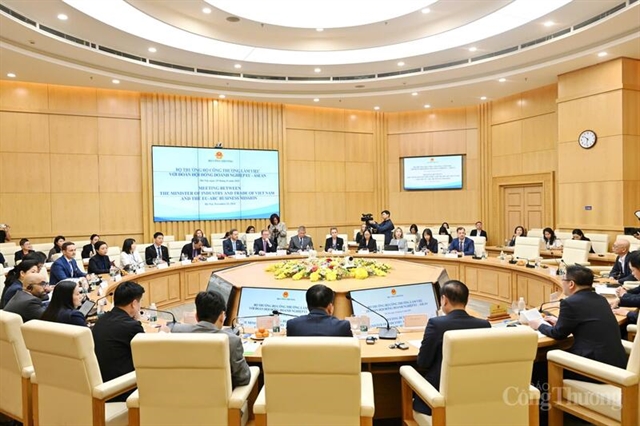 Society
Society

 |
| Aloe vera plants are grown under Vietnamese good agricultural practices (VietGAP) in Ninh Thuận Province’s Thuận Bắc District. – VNA/VNS Photo Nguyễn Thành |
NINH THUẬN – Ninh Thuận Province is making efforts to research and apply high technology in agriculture production to improve the yield and quality of agricultural products.
The south-central province has developed many high-tech farming models which use net and polygreen houses, efficient irrigation, Vietnamese and global good agricultural practices (VietGAP and GlobalGAP) and organic standards.
It has developed new varieties of specifically identified products such as grapes, jujube, aloe vera, asparagus, shrimp fry, goat, sheep, marine fish and bivalve molluscs.
The country’s largest grape producing province has researched and created many new high quality grape varieties such as seedless black grape NH04-102, pink grape NH01-152 and Mẫu Đơn grape NH01-212.
These varieties, which are created by the province-based Nha Hố Research Institute for Cotton and Agriculture Development, have the advantages of having high quality and yield, and being nicer looking and bigger than traditional grape varieties.
The institute has transferred these varieties to farmers and co-operatives to replace other grape varieties.
It has also instructed them to apply advanced techniques to grow the fruits, including using net and poly green houses and a Y-shape trellis.
Thái, An General Agriculture Co-operative, is the first co-operative in Thái An grape village in Ninh Hải District’s Vĩnh Hải Commune to grow grapes under the institute’s instructions using the poly greenhouse model.
Nguyễn Khắc Phòng, its director, said growing grapes in a poly greenhouse avoids the impacts of unfavourable weather, is highly efficient, and uses few plant protection chemicals and fertilisers.
“These grapes meet clean and safe standards,” he said.
The high-tech farming of these new grape varieties offers farmers a profit of VNĐ1-1.2 billion (US$40,000-48,000) per hectare a year.
However, the initial cost of growing grapes in net and polygreen houses is high, so the area of grapes planted in net and poly greenhouses is still small.
According to the Department of Agriculture and Rural Development, the province has 825ha of high-tech farming areas, which have an average production value of VNĐ938 million ($37,500) per hectare a year.
The production value of high-tech agriculture accounted for 13 per cent of the province’s total agriculture production value last year, it said.
One of the achievements of high-tech agriculture is that the province has become the country’s centre for high-quality shrimp seed production.
The province has 27 companies that apply high technology to produce shrimp seeds.
The province’s two products (parent black tiger shrimp for producing shrimp seeds and aloe vera jelly) have been exported since last year.
The province has 38 high-tech farming projects that operate effectively and three concentrated high-tech farming areas—a shrimp seed-producing area, a safe vegetable-growing area in Ninh Phước District, and a shrimp breeding area in Thuận Nam District.
It has developed 37 production codes for 321ha of farming area and 70 value chain links for producing agricultural produce on a total area of 15,000ha.
Đặng Kim Cương, director of the department, said the province has implemented many policies to develop agriculture and rural development, and to encourage companies to invest in agriculture and rural development.
He said these policies have helped co-operatives and farmers invest in efficient irrigation and produce agricultural products using VietGAP and other high-quality standards.
Research projects
The province is implementing 24 national- and provincial-level science projects this year, mostly in agriculture development.
They include researching and setting up an integrated pest management model for asparagus, suitable models for marine aquaculture in zoned areas, and a model of growing aloe vera in specialised areas.
The province is also developing research projects about processing agricultural produce to increase product value such as a project of using Cô đơn banana, a specialty, to make wine; and a project of using modified atmosphere packaging technology to preserve fresh goat and sheep meat.
Trịnh Minh Hoàng, deputy chairman of the province People’s Committee, said the province is mobilising various resources to implement highly applicable tasks in agricultural production and climate change adaptation.
It is implementing science and technology in agricultural production and climate change adaptation under a co-operation agreement between the People’s Committee and the Việt Nam Academy of Science and Technology until 2030, and a programme to coordinate activities in science, technology and innovation with the Ministry of Science and Technology in 2023-25, he said.
The People’s Committee has assigned its Department of Science and Technology, in cooperation with relevant departments, research institutes, universities, and scientists, to increase research and selection of new plant varieties and apply high technology in agriculture production.
The province will focus on applying biotechnology, organic agriculture, nanotechnology, information technology, digital agriculture, automation, net and polygreen houses, and VietGAP and globalGAP standards in agriculture production.
It will encourage the establishment of co-operatives and linkages among farmers, authorities, enterprises and scientists.
The province produced agriculture worth VNĐ3.3 trillion ($132 million) in the first half of the year, an increase of 4.7 per cent year-on-year. – VNS




